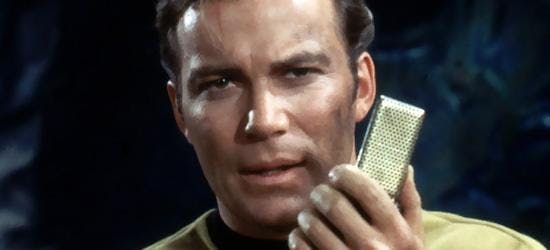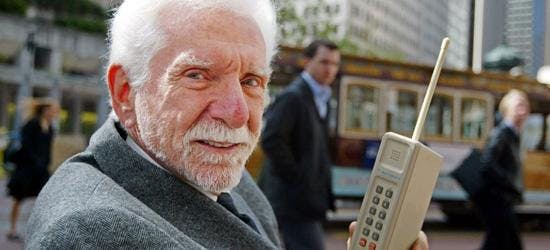Published Apr 3, 2014
First Mobile Phone Call Made 41 Years Ago Today
First Mobile Phone Call Made 41 Years Ago Today

Captain Kirk never actually said, "Beam me up, Scotty,” but if he did he would have said it on his communicator.

Warp drive, holodecks and replicators still dazzle us, but back when Star Trek first aired a lot of what we now take for granted seemed like it came from a strange, new world. Much like the giant visual screens and the portable data-rich “computer tapes,” the communicator was a gadget that grabbed everyone's attention because it wasn't THAT dissimilar from the technology that already existed. But the communicator was more than a walkie talkie and it was more than a phone, and the way it flipped open, chirped and then hung on a crewman's belt made it irresistible.
While mobile phones only became affordable for average people in the 1990s – and today are so vital that the actual voice communication aspect of the ubiquitous devices feel like an afterthought – cell technology has been around a lot longer than you might think. Indeed, today marks the 41st anniversary of the first mobile phone call. 41 years! That's five months older than Star Trek's animated adventures! That's 10 years older than Walter Koenig was when he first appeared in TOS' season two!

In an act of Kirk-like bravado, Motorola's inventor Martin Cooper (still alive at 85) made the first mobile phone call while standing on Sixth Avenue and 54th Street on April 3, 1973, calling his rival Joel Engel at Bell Labs. Reporters were on the scene, so Cooper simply said “I'm calling you from a cell phone” instead of “in your FACE, son!”

Cooper has stated many times that watching Original Series Star Trek was absolutely an inspiration for his vision. Kirk's ability to be mobile and stay in touch with his crew was what drove Cooper beyond the limiting range of even a car phone. (Which was still a fairly novel thing as late as the 1980s.
The first cell phones had limited battery power and were enormous (my first cell was heavy enough to fell a Gorn), but as time moved on the Motorola company looked toward Trek again. The most popular model from the mid-90s actually flipped up with an agreeable snap just like a TOS communicator. It was also black. The name? The StarTAC. Yeah, you don't have to be a top of your class at the Daystrom Institute to figure that one out.
While the phasers of The Next Generation got bigger, the communicators got smaller. So small, in fact, they weren't even there. Like the smartphones of today – with their telephony bundled in with other versatile uses – the combadges that took over for the handheld communicators were used for audio communication as well as a constant homing beacon. If trouble popped up, transporter room engineers could quickly lock on to someone and beam them out of there thanks to the combadge. Heck, if you just wanted to go hang out with Geordi La Forge but didn't know where on the ship he was, a simple query to the ship computer would tell you where he was hanging out. (Probably down in Engineering, poking around with warp coils.)

Anyone who has ever left their iPhone in the back of a taxi but had the location services function on has been able to watch their device tool around the city remotely. Same goes for “dropping a pin” for letting a friend know where to find you in a park or something. These are abilities straight out of TNG's combadge.
While the functionality of Siri isn't quite at the level of the shipboard computer (and Siri doesn't have quite the friendly tone of Majel Barrett-Roddenbery), the ability to just bark out a question and to (usually) get the right answer is something that still feels like science fiction to me.
As much as cell phones are essential to our lives, the communicator has been essential to the adventures of our beloved Star Trek characters. If Kirk and Spock couldn't communicate “by the book,” then Khan might have gotten his hands on Project Genesis after all (to use just one example).

Would we have smartphones today even without Star Trek? Yes, probably, I'm sure. But with Cooper on record as saying Trek first blew air into the warp bubble of his mind, it's hard not to take a little pride, as Trekkies, that our franchise is at least partially to thank for our current technology. As such, if you are reading this on a portable device on a bus or something, hit that button to share on Facebook and Twitter to rub it in all your non-nerdy friends.
Jordan Hoffman is a writer, critic and lapsed filmmaker living in New York City. His work can also be seen on Film.com, ScreenCrush and Badass Digest. On his BLOG, Jordan has reviewed all 727 Trek episodes and films, most of the comics and some of the novels.
